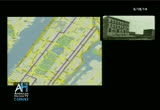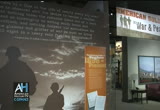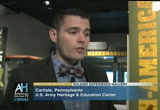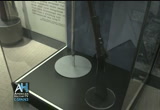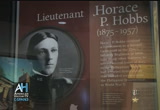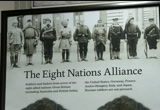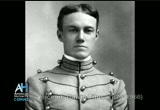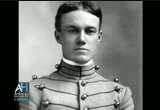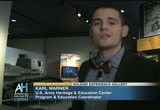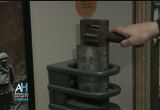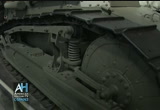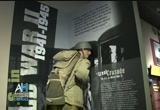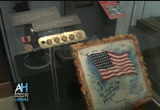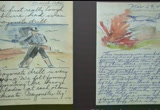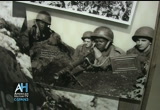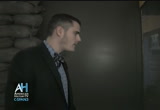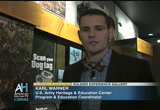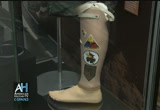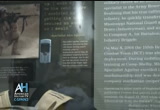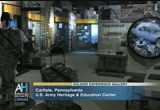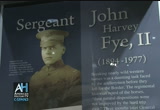tv American Artifacts CSPAN July 5, 2014 10:00am-10:28am EDT
10:00 am
the brownstone neighborhoods were built around the park between the civil war and world war i. it is still a remarkable place, a very different country. i believe that is the triple pond, and that would be the central lawn where the original reservoir used to be. you are looking toward 5th avenue. a remarkable piece of work. truly another country. vaux, you, olmstead and for that. >> you're watching american history tv, 48 hours of every weekend on c-span 3. follow us on twitter to keep up with the latest history news. each week, "american artifacts"
10:01 am
visits museums and historic places. next, a visit to the u.s. army's archives in carlisle, pennsylvania, to learn about their soldier experience gallery, which traces army history from the 1898 spanish american war to the present. >> welcome to the u.s. army heritage and education center in carlisle, pennsylvania. my name is carl warren. i'm going to show you around today. this is the part of the facility more like a museum rather than an artifact archives or storage facility. it's our way to show the american public the sort of materials we have here, so you can understand army history, whether you're a soldier and a veteran or someone who has never had family or been in the army themselves. we start the timeline for this exhibit with the spanish-american war because that's when our collections have the very first recorded audio oral histories of soldiers who actually experienced the war itself.
10:02 am
of course the spanish american war we have the title, the great adventure, because the army was not ready to go to war at this period of time, when the u.s.s. maine exploded in havana harbor and cubans rebelled against the span ir, everything came to a head and we declared war on spain. spain declared war on us and the war started in earnest in a lot of soldiers enlisted all at once. we didn't have any sort of underlying setup, any sort of logistics ready to go to supply all these soldiers. so between not being able to ply the soldiers to begin with but going to war any way and seeing the consequences of the spanish american war afterwards, kind of foreshadowed the america's ability to fight war throughout the 20th century. so we start with spanish american war in 1898 and we move on through and show different soldiers' stories throughout the exhibit.
10:03 am
the great part of these glassed-in sections of our exhibit, which is only 7,000 square feet, is that we can show different soldiers stories over time and switch them out easily to get our massive collection of artifacts and soldiers' stories through the exhibit. one of our very first stories we display in the exhibit is cantor -- kinter. kinter's collection is kept in our storage facility. we have here would primary pieces from this collection, one is the blouse that he wore during his service. and the other is his 1884 trap door springfield rifle. it was a very obsolete rifle. soldiers were eventually given much better weapons than that, over time. but he kept a great diary and we're able to show his entire
10:04 am
soldier's story through not only this exhibit but also our archival holdings of photographs, diaries and manuscripts from soldiers like private kinter. we move from the spanish civil war to the philippine insurrection. the philippine insurrection was part of the spanish-american war. the people of the philippines expected the u.s. would grant them independence, and when we didn't, an insurgency started, much like the insurgencies that we're getting done fighting today in iraq and afghanistan. many of the southerns who went over there kept war souvenirs and one freight collection we -- great collection we have here of lieutenant hobbs, he went over, he had many different jobs while in the philippines. but one thing he did was collect
10:05 am
many edged weapons and materials that insurgency groups had the philippines used against americans. it's a very bloody portion of our history, but it's one that needs to be told, specifically through soldier stories like lieutenant hobbs. some of our best collections of edged weapons in our artifacts storage facility are these insurgent weapons from the spanish-american war and the philippine insurrection. as we move on, the army doesn't just stop in interwar years. we did send a contingent of soldiers to the china relief expedition, more popularly known as the boxer rebellion. along with the british, austrians, russians, germans. and in that time we helped to secure peking, which would later be called beijing. it was a -- it was one of the
10:06 am
first examples of the american army fighting alongside other nations, and really became the first real international operation marked by american cooperation with other countries. one interesting piece we have in our collection here at the army heritage and education center , and is accessible via several of the q.r. codes we have in the exhibit, in this case is calvin titus. titus won a medal of honor for daring and galant conduct, he was one of the first soldiers to scale the walls of peking during the boxer rebellion. this q.r. code will take your your cell phone, to a recording of his actual oral history. >> this is something that took place a long time ago and it's followed me. i can't get away from it. >> but the wall looks like the one you scaled? >> yes, that's a very good representation of it.
10:07 am
of course, as you see that fellow standing on top there, well now, that would have been impossible. that thing, those stones are round up on top and narrow and nobody could stand up there unless he was an acrobat. >> what did you think at the time you were scaling it, were you sure you would make it or did you have doubts about it? >> well, i thought i'd make it all right. i wasn't very much afraid of that because i was a fairly good climber. but of course i never thought about what i was getting into. [laughter] >> i understand that when president the door roosevelt -- theodore roosevelt personally ittadal, you with the
10:08 am
was on the parade ground at west point, is that correct? >> yes, they turned out the corps in full dress. i saw someone coming up toward me with the superintendent, and he got close enough i saw it was teddy roosevelt himself. and the adjutant -- the adjutant handed him a box that held the medal itself and he took it and started to pin it on my full dress coat here and he said to me, now, young man, don't let this give you the big head. [laughter] >> wonderful. that's wonderful. >> before world war i there was a small conflict called the mexican border crisis. we faught against the outlaw pancho villa down on the new mexico border with mexico. and of course we have material in our collections outlining what it might have been like to be a soldier in that troubled period between us and the
10:09 am
mexicans. we have an amazing world war i collection, very expansive, everything from soldiers' diaries, photographs, all the way up to memoirs and histories of commanding generals. to start out we show a hotchkiss machine gun. of course we've demilitarized it for the exhibit. ,he hotchkiss machine gun peeking out over the top of a world war i trench. the war very quickly devolved into trench warfare, as machine guns and artillery forced soldiers, who were used to fighting in a 19th century fashion -- are now forced to fight with automatic weapons and artillery, and that causes to go down into the trenches to avoid those new weapon systems. we're going to talk about a few of those weapon systems right
10:10 am
over here. a high explosive artillery shell during world war i made an enormous amount of noise when it exploded. sometimes gas shells didn't make as much noise, of course gas being mustard gas and chlorine gas, and these sorts of irritants that would do everything from bring a soldier down so he can't fight, all the way to killing soldiers. so if a gas canister or gas artillery shell goes off near you and you want to be able to warn other soldiers in your trench line of that gas, you're going to need something loud enough to get over the din of warfare to warn them that an artillery shell just went off. this artifact here is a wooden gas alarm. normally you would take it above your head and swing it around. however, we bolted it in for safety's sake. but you can hear the noise it makes. if you had three or four of those going off at the same time, everyone around you would know it's time to mask up and get ready for gas to -- for the wind to push gas over the top of you.
10:11 am
what we have right here is an excellent specimen of an ft17 french-designed renaud tank. this tank was built by the americans and used to train the soldiers in france on how to drive and fire the main weapons on tanks. remember, before this tank there weren't tanks. the british had tanks and the germans had tanks, but there were no tanks prior to this first generation of tanks. this piece right here is the tank that george patton fell in love with. of course general patton would go onto become the grandfather of american armor. you can see some of the aspects on this tank are very similar to tanks we have nowadays. you have a tour it that can turret that can rotate 360 degrees. the one thing i'll point out, or
10:12 am
a few things i'll point out, first the treads themselves are very aggressive, they're far forward of the tank ands you can see how the treads are designed to grip. the idea being that if this tank had to go down into an enemy trench line, it would be able to pull itself up the other side. further more, in the back you can see a scoop, that scoop was designed to steady the tank so that it could go over longer and longer trench lines, or rather wider and wider trench lines. this front load wheel is made of road wheel is made of wood. the reason for that is at the time the steel that could have been idea for that front road wheel, there would be too much friction and it would heat up too fast, become too brittle, and the vehicle could break. the strongest but most resilient material we had at the time was live oak. and we used live oak to build those front road wheels so that they would be sturdy enough to
10:13 am
deal with the torsion pressure without heating up too much. we've got great footage in our collection. i've talked about diaries, manuscripts, and photographs. we also have an extensive video collection, and a team of experts that are able to digitize them. and as we digitize these videotapes, we are able to get them online, and of course show them in our main exhibit here. these videos of course are of ft17's in action moving around behind the lines getting ready to go to the fight. after world war i, we entered a period of "peace in
10:14 am
hard times," we call it in the exhibit. as the war died down and we started to reduce our forces, one of the big aspects of how the amendment was dealing with the interwar years and the progressive nature of some of the politicians was integrating the united states army. over here we have another soldier's story, in this case brigadier general benjamin davis. davis joined the army in 1898, fought in the philippines, and eventually moved his way up through the ranks to become the very first black general officer in the united states army's history. we have his entire collection here and as you can see here it includes medals, his ceremonial saber, his class a uniform. and of course we're very proud to have his collection here, especially for folks who want to come in and do research on the desegregation of the united states army. he was very instrumental in that process. after the interwar years the united states army entered world war ii and had to bring the army back up to strength very very quickly. in this case, you can see a soldier with his duffle bag ready, getting ready to go overseas to fight the german
10:15 am
army, or perhaps the japanese. as we move through the exhibit, you can see that we had several different theaters in which these soldiers were shipping out to fight. each theater had its own uniform, its own tactics, its own way of doing things. this is neat to show, because it shows how the army heritage and education center can take more than a uniform and a gun and put it up on display. here we have specific items important to this, in this case p.f.c. sam adgent. and his time in the army. we have got buttons, which he probably spent many days and nights polishing to a bright shine for the countless times he is probably being inspected by his superior officers. you can see the belt that he probably strapped a pistol to when he went off to war. he was a military policeman, so he also carried a whistle. and there we have a little piece
10:16 am
of history of this military policeman and the whistle he carried to alert soldiers, direct traffic, issue command, the whole nine yards. we even have his training bulletin and pieces of material that he brought back from the war. another aspect of our collections that are phenomenal and are really unmatched anywhere else is the art collections. we have a great deal of artwork, but right here you can see materials from sergeant dominic, sergeant dominic took sketch books and water colors with him to the fighting in world war ii, specifically in the philippines, and then into various island campaigns. you can see here sketches and watercolors. the beauty of these selections is it shows us how a soldier saw through his own eyes the fighting, and the difficulties
10:17 am
that a soldier deals with in war. through photographs you see a still image, a sanitized image of only what's within the frame. through the artwork, you can see the feeling that the soldier has for that particular aspect of war. another good collection we have here, we've seen a lot of soldiers' stories from men. this -- from men. in this case, we have a woman who joined the army right before world war ii, captain hannah tussie. she served in the thick of things in combat hospitals throughout world war ii, working as a scrub nurse, repairing materials for the surgeons, to help save soldiers coming back from the front lines, wounded. after the war, she moved into the army reserve, and actually
10:18 am
fought in vietnam, served as a nurse in vietnam, and served as a lieutenant colonel. we have her collections here including diaries, photographs, you can see her nurses uniform from world war ii here fantastic stuff to see the entire story of a very strong woman in the united states army. we move into the cold war and in this case one aspect of the cold war is the korean war. some people call it the forgotten war, because unfortunately it's not featured a lot in the media. but it was an undeclared war of police action as it was described at the time by some politicians. but it was a full-on war. and as in many other times in united states army history the soldiers deployed to the war, weren't always given the right equipment, and it got very very cold during the winters and very hot in the summer. but the soldiers soldiered on, so to speak, and held off the
10:19 am
chinese in the north korean invasion over time. we have some great artifacts from the collection. of course the cold weather is really one of the big aspects of the war itself. and in in case you can see a field cap from the time and also what was called mickey mouse boots. they were a long time coming to some of the southerns, they had to wait a while before they got these, but they were able to keep a soldier's feet warm and prevent frostbite. but they were difficult to wear, they cause your feet to sweat, and sometimes that sweat froze. it made foot care very very difficult in these cold conditions, but over time soldiers figured out the tricks to keeping their feet warm. we also have one more soldier's story in this exhibit, first lieutenant emigh, fought through
10:20 am
world war ii and ended up in the korean war. in this case he was second infantry division, and as you can see, his uniform and purple heart from a gunshot wound during the korean war. as the cold war continues, we move on to another undeclared war, but a war nonetheless, in this case vietnam. in one interesting aspect of the exhibit is a series of photographs we show of the sort of dangers that a soldier walking through a junk nell , thengle in vietnam dangers they dealt with, booby traps. really vietnam shows every aspect of warfare, from fighting in damage, dark jungles, all the way to fighting in highlands, to fighting in dryer areas.
10:21 am
the american soldier during vietnam had to deal with every type of warfare. one of our very best soldier stories from vietnam is from joe newsome, a great friend of this facility in fact. he was a helicopter pilot and flew numerous, numerous missions over vietnam. you can see some parts of his collection here. we have his flight helmet, we have his uniform. and we have a flight bag to hold the helmet, decorated with the various unit insignias in which he served. you can see that really great first division patch on the front. another great part of captain newsome's collection that is absolutely invaluable is the film that he shot from the helicopters that he flew.
10:22 am
he was a huey pilot, would hook up the camera in the main door of the huey itself and shoot film of his mission. and this gives us the ability to see what it might have been like to be that door gunner, sitting in newsome's helicopter, and actually in combat, in night, running those missions. -- in-flight, running those missions. it is a viewpoint that very few people eventually ever have. -- have ever actually had. the cold war ends and then we go and we fight saddam hussein in desert shield desert storm. again, amazing aspect of our collection are the photographs, the videos, the oral history interviews from the soldiers who were on the ground during desert
10:23 am
storm to fight the iraqi army. we have seen a private soldier's story, we've seen a nurse's soldier's story. this right here is one of the soldier's story of a collection we have on general fred franks. frederick franks. one interesting aspect of his career, a very wide and expansive career in the army, commanding troops at every single level as you can see at four stars, is that we have his prosthetic leg. he comes back to visit us routinely, and of course we have his leg for him to see. but it's an interesting piece because he lost his leg in cambodia during vietnam. the vietnam war. and he was able to continue with his career with that prosthetic leg. again moving up through the ranks and becoming one of the most influential generals in the united states history.
10:24 am
of course, we move into a peacetime army, post cold war, after desert storm and desert shield and through, we did have conflicts in places like bosnia. but as we move through you can see we get to finally the war on terror. we are currently collecting materials from current, soldiers who are currently operating and soldiers who are recent veterans. if you know of anybody who has materials from their time in the united states army, this is the place for that material to go. it allows us to show every as -- every aspect of a soldier's life and allow the american people to understand what it was like to be a soldier. in this case we've got the soldier's story of special ist aguilar. we regularly change out his materials because we have an extensive collection of his materials. interesting piece up in the side there is his zone i erickson -- sony erickson telephone.
10:25 am
he did not actually use that cell phone to make phone calls when he was in iraq and afghanistan, rather he used it to help do the mathematics behind the targeting for his sniper rifle. in fact he told us this story and told us that on night missions he didn't even use that telephone because of the light emitted from the cell phone itself. little bits and pieces of the soldier's story, just like that cell phone, are what give us that whole view of the soldier and can better understand the history of the united states army. you can see a piece right there, a section of improvised explosive device. of course one of the main concerns of most soldiers in iraq and afghanistan was the i.e.d. we have an exhibit over here put together by one of our staff members who actually was on an e.o.d. team in iraq. he was wounded by a sniper during a mission, but now he is one of our exhibit designers. and he put together this exhibit
10:26 am
right here. this is different views of what he saw as an explosive ordinance disposal soldier in iraq. you can see different ways that insurgents might build an improvised explosive device. for those of us who are veterans of this war, these pieces right here really bring out a visceral reaction. these are the sorts of things we dealt with every single day. we show off a lot veterans materials here. we allow the american public to understand the soldier's experience and what it was like to be a soldier. and of course for us to be able to do that, we utilize the veterans' materials. so if you have a diary, if you have a uniform, and you're interested in showing it to the world and to allowing us to better our mission, please come on by and talk to us about it, we'd love to have you.
10:27 am
[captioning performed by national captioning institute] [captions copyright national cable satellite corp. 2014] >> our endowment is the largest amount in the u.s. it is pretty healthy, just short of $600 million. to put that into perspective, others in our peer group are at $6 billion. howard represents the tenant -- harvard endowment represents the pinnacle of endowment. if we are going to aspire to have that type of excellence, the facilities to produce that excellence in our campus, we have to have that type of investment. it is my responsibility in the interim and will be the 17th president's responsibility to go out and
40 Views
IN COLLECTIONS
CSPAN3 Television Archive
Television Archive  Television Archive News Search Service
Television Archive News Search Service 
Uploaded by TV Archive on

 Live Music Archive
Live Music Archive Librivox Free Audio
Librivox Free Audio Metropolitan Museum
Metropolitan Museum Cleveland Museum of Art
Cleveland Museum of Art Internet Arcade
Internet Arcade Console Living Room
Console Living Room Books to Borrow
Books to Borrow Open Library
Open Library TV News
TV News Understanding 9/11
Understanding 9/11